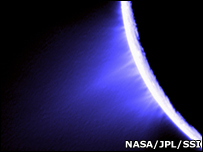Moon Jets Pinned On 'tiger Stripes'
Moon jets pinned on 'tiger stripes'
From: http://news.bbc.co.uk/2/hi/science/nature/7039581.stm
Oct 12, 2007
Scientists have determined the location of the most powerful jets spraying from the south pole of Saturn's moon Enceladus.
These ejected streams of ice particles come from the hottest spots of geological fractures known as the "tiger stripes".
The results, reported in the journal Nature, delight scientists who study Enceladus, even if they do not come entirely as a surprise.
"This confirms that these jets really are coming from these geologically fascinating grooves, which really are the warmest places," said Nicholas Schneider, a planetary scientist at the University of Colorado, US.
He was speaking here at the American Astronomical Society's Division of Planetary Sciences meeting.
Joining the dots
Drawing on two years of images and data from the spacecraft Cassini, researchers compared the locations of three types of feature.
One consisted of eight jets of material coming from the moon. The second was the tiger stripes; and the third, the areas of warmer temperature detected at the southern tip of Enceladus.
In almost every case, the three types of features coincided, said Joseph Spitale, a planetary scientist with the Cassini Imaging Central Laboratory for Operations (Ciclops) in Boulder, Colorado, and a co-author of the Nature paper.
The correlation raises intriguing questions about the geological activity that is causing the spray of icy particles to burst forth, and what lies beneath the hardened crust; whether it is a thin sheath of water or a lunar ocean.
Fuzzy logic
The Cassini spacecraft first spotted the jets when it flew by Enceladus in 2005.
Alerted to disturbances in Saturn's magnetic field, and to a curious fuzzy patch in images of the moon's south pole, scientists directed the orbiter to fly closer later that year.
Scientists spotted the grooved tiger striping, and identified the fuzzy spots as jets - whose 100km-high plumes were perturbing the magnetic field - but not their precise origin.
Separate measurements taken by the Cassini Infrared Spectrometer (CIRS) identified areas of warmer temperature in the region.
To determine whether the observations were related, Dr Spitale pinpointed the most prominent jets by triangulating their location using pictures taken from an array of viewing angles by Cassini's imaging camera.
Eight jets were located along four two-kilometre-wide tiger stripes - named Alexandria, Cairo, Baghdad and Damascus - and nearly all of them appeared to come from surface hotspots.
That two jets appeared not to be directly on hotspots might be due to lack of infrared data, said Dr Spitale.
At a temperature of minus 130C, the spots are only hot in relation to the overall landscape, at minus 200C.
What keeps them "hot", Dr Spitale believes, is that ejected material falls back on to the moon's surface around the ejection site.
Tidal tale
The existence of hotspots apparently without jets could be explained by the images being taken when the jets were not active.
Like the geyser Old Faithful in Yellowstone National Park, Enceladus jets may have timed releases.
These might be controlled by tidal forces stretching and squeezing the moon's surface, said Terry Hurford, a planetary scientist at Nasa Goddard Space Flight Center near Washington DC.As Saturn's gravity tugs on Enceladus, he said, metre-length cracks within the fractures might pull apart, releasing the spray, composed primarily of water - or fine ice particles - with carbon dioxide and nitrogen gases.
As to the origins of the jets, scientists can only theorise.
Perhaps ice and gases are compressed and trapped in clathrates, frozen bundles that suddenly release their gases when exposed. Or, rubbing caused by tidal forces causes the icy crust to give off water vapour and gas; or both mechanisms are at work.
There is another tantalising possibility: a subterranean ocean.
Analysis of the composition of the water in the jets, currently underway by Dr Schneider and his team, may help answer this question.
Whether the water is fresh or salty may reveal whether Enceladus is hiding an ocean beneath its icy shell.
All of which makes Enceladus a fascinating target for a future, dedicated mission. Scientists are already considering how they would get instruments down on to the surface of the moon.
In the meantime, Cassini itself will be commanded to fly through the jets in March next year.
The Cassini-Huygens mission is a cooperative project of the US space agency (Nasa), the European Space Agency (Esa) and the Italian Space Agency (Asi).



